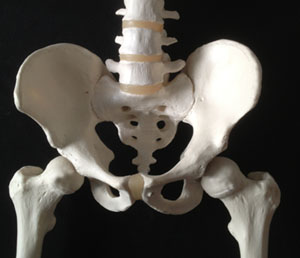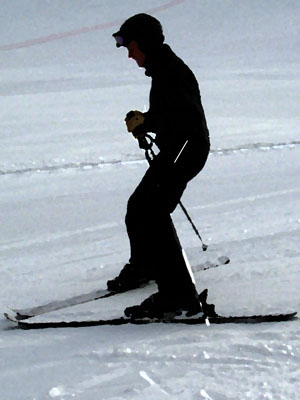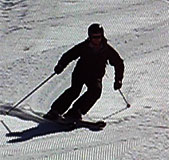Incorrect pelvic tilt has interested me for years. It often goes undiagnosed and can be the cause of many technical problems for skiers. And it’s not just a beginner’s problem. I skied around for years with exactly this issue. I must have disguised it pretty well – none of my coaches, trainers or examiners picked up on it. I knew I had a problem: my left turns skidded more than my right turns. I’d figured out that this was due to my right hip pushing out when I tried to angulate in left turns and this flattened the ski causing loss of grip. But try as I might to angulate more, it seemed to make the problem worse. I knew there was a blockage somewhere, but couldn’t isolate the cause. Then quite by chance, while I was working on pelvic tilt in another context, I noticed my hip problem had gone away! It also cured a peculiar left arm position that I had – kind of hanging out to the side and back when turning left – but I never connected the two. The moral of this story? If you have a problem with pelvic tilt, you may find it difficult to diagnose, even with video feedback and help from an instructor.
Pelvic tilt is rarely mentioned in manuals and books. Ron LeMaster’s update to The Skier’s Edge, Ultimate Skiing now has a brief treatment of lower back posture (pp 62-3). Lito’s Breakthrough on Skis has always mentioned a relaxed lower back as a pre-requisite for separation of upper and lower body. And R Mark Elling’s The All Mountain Skier has a paragraph tucked away at the back describing hollow back syndrome and “dinosaur arms”. But by far the most rigorous treatment is in John Sheddon’s 1982(!!) book Skillful Skiing. I’ve always been impressed by Snowsport England’s approach to skier analysis, and John’s book still leads the way – 30 years on!
So what is pelvic tilt and why is it important? Your pelvis connects your legs to your upper body:
The angle of the pelvis is controlled by the muscles in the lower back. Excessive tension in these muscles causes the pelvis to tilt either downwards (anterior) or upwards (posterior) relative to its neutral, relaxed position, thereby blocking independent movement of lower and upper body.
A skier with excessive downwards pelvic tilt. Note the hollow back, shortened arms and pulled-back shoulders. This skier will tend to move torso and legs together as a unit and will not be able to angulate properly to edge the skis, causing excessive skidding.
Excessive upward pelvic tilt looks like this. It is less common than downward tilt. This skier will tend to sit back, causing excess pressure on the back of the skis, making it difficult to turn without using the whole body.
But it’s not always as obvious as this.
Does this skier have a problem? Look out for odd arm positions, asymmetric left/right turn performance, and outside hip sticking out.
So, if you think you might have incorrect pelvic tilt, how do you cure it? It’s all about relaxing the muscles in the lower back. Imagine someone has just whacked you in the stomach – oof! The resulting posture – stomach pulled in, shoulders and arms forward, lower back relaxed and rounded – is a great ski position. And if you don’t have enough imagination, get someone to whack you for real …




